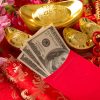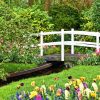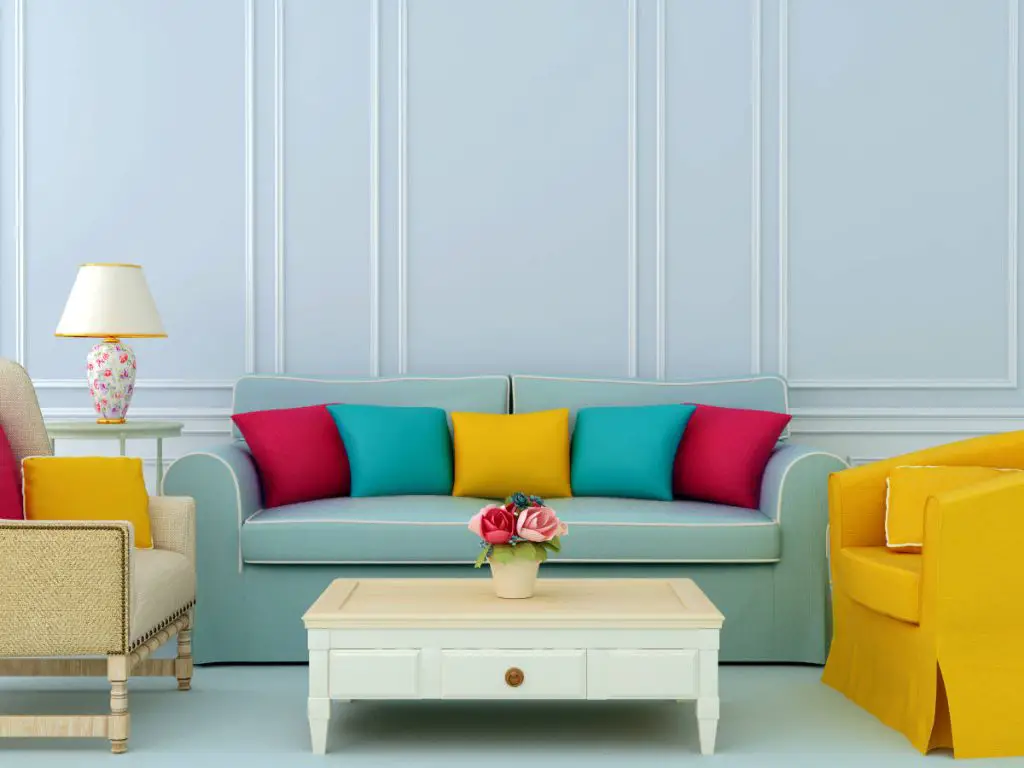
Color is an essential component in feng shui, and it is linked to numerous feng shui concepts and Taoist cosmological schools of thought. It is one of several strategies used by feng shui practitioners to change the energy of an area. Color has a major impact on how we feel, and it’s also one of the easiest things to adjust in a room.
Contrary to popular belief, feng shui is not a decorating strategy or style. It is both an art and a science that seeks to balance and harmonize, ultimately increasing your personal energy levels.
Feng shui stimulates your subconscious mind to make new decisions based on what you wish to bring into your life. Feng shui can assist you whether you’re looking for money, harmony, happiness, or something else.
According to feng shui, it is vital to carefully select the colors for everything in your home, from paint to decor and furniture. Even simply changing one color for another might boost your mood. Each color signifies a particular form of energy, or qi, that powers all living things.
There are several ways to approach color from a feng shui perspective. One of them, and perhaps the simplest, is the five elements’ color system.
According to Feng Shui, each of the five elements—fire, earth, metal, water, and wood—is symbolized by particular colors. The idea is that by using certain colors, you can manipulate the energies of these elements and, consequently, your feelings and emotions.
In this article, we will see how to find the best color combination for every area of your house according to your intentions.
Remember, though, that there is nothing in feng shui that says you have to paint your walls a certain color. When selecting colors for your home, it’s vital to keep in mind that various colors can have a variety of cultural connotations and personal significance.
But first, just a few words about how colors relate to each other, and the kind of emotion they can produce in our environment.
Creative and Controlling Cycles of Elements
You may easily choose colors for your area by knowing the qualities of feng shui elements and selecting the ones you’d want to highlight to increase the energy. The following are the basic elemental associations:
- Fire: passion, energy, excitement, joy, anger, aggression, dynamism.
- Earth: grounding, growth, stability, nourishment, strength, relieving anxiety and stress.
- Metal: structure, precision, clarity, organization, introspection, self-reflection, productivity.
- Water: cleansing, flow, purity, flexibility.
- Wood: revitalization, growth, renewal, health, and vitality.
Creative or Productive Cycle
The creative or productive cycle demonstrates which elements contribute to the energy of another element. For example, if you wish to strengthen a specific element, pick things that symbolize both that element and the element that helps to strengthen it.
- Wood feeds Fire
- Fire creates Earth
- Earth molds Metal
- Metal carries Water
- Water feed Wood
Controlling or Destructive Cycle
Each of the five elements can also be used to balance the others. This is handy if you believe you have excess in particular parts of your life that you would like to control.
- Wood splits the Earth
- Earth absorbs Water
- Water extinguishes Fire
- Fire melts Metal
- Metal cuts Wood
Related reading: Feng Shui Tips for Good Luck: Simple Practices for Big Results – Opens in new tab
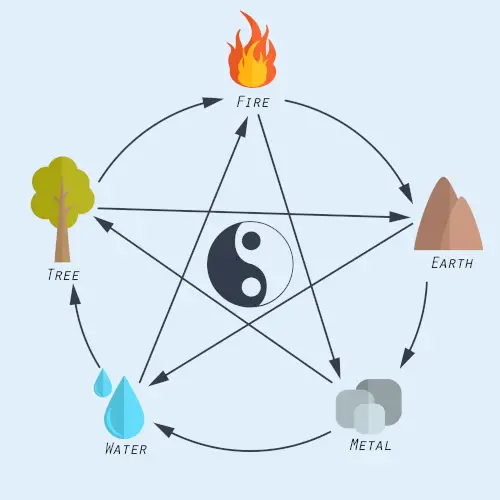
How to Use Bagua Map to Find What Color to Use in Each Area of Your Home
A Bagua map can be used in Western Feng Shui to identify regions in a home that correlate to a feng shui element and the most auspicious use of that room.
The Bagua Map can be used in a variety of ways. The most common is to align it with your floor layout. Simply lay the Bagua map (below) over the layout of your home or room, with the bottom of the map aligned with the front of your house. That is, your entrance will fit within the Travel & Helpful People, Career & Life Journey, or Knowledge & Self-Development areas.
Using the bagua map to identify the area gives you insight into the elements and colors that will boost the vitality of the room. You can also use this simple rectangular Bagua map to figure out which part of any room represents the feature of chi energy you want to improve. This is a great way to find feng shui colors you like.
According to the Feng Shui Bagua method, each of your house’s nine sectors (North, South, East, West, Center, etc.) has an element that influences different types of luck in your life.
Using colors of the same element or colors that are beneficial to the element of the sector could assist in improving the type of luck represented by the sector.
The North sector, for example, influences career luck, and its element is water. As a result, feng shui colors that correspond to the water element, like blue, navy, and black, are appropriate for this sector. And, because Metal carries Water, the metal element colors white, gold, silver, and gray are also suitable for activating career luck in this area.
Wood and Earth colors should be avoided for the northern sectors since these elements weaken or destroy the Water element in the five-element destructive cycle.
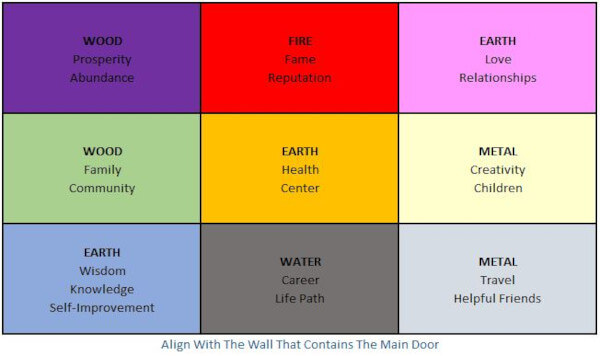
How to Choose Feng Shui Colors to Achieve Your Goals
Since Feng Shui principles do not dictate certain colors, you have the option to select colors that inspire and excite you.
It is very important for you to understand why toning down or up certain Feng Shui colors in your home will help you reach the goals you have set for yourself in life.
When employing Feng Shui colors, the goal should be to achieve balance rather than excess. Whether you’re designing the color scheme for your house or office, the following Feng Shui color qualities can help you understand how they might be employed in Feng Shui design.
Want to learn more about Feng Shui? Check out our suggestions: Feng Shui Bookshelf – Opens in new tab
Feng Shui Colors and Elements
Colors will help to create the proper ambiance in your home, but we have to always keep the balance of the colors and the five elements in mind. Here are some of the basic feng shui colors according to their element:
Fire Element Colors
Red: Red is the most auspicious color in feng shui, and its influence is undeniable. It can be utilized to bring prosperity, health, and good fortune. The color red is also associated with visibility, inspiration, and clarity in the Fame section of the feng shui bagua map.
Red is also incredibly active and stimulating, and for some people, too much red can be overwhelming. It is frequently used to protect and clear the energy of a home or a person.
Large amounts of red should be avoided in areas intended to be more relaxing, such as bedrooms. So, use it sparingly to reroute energy around the house. A wonderful rug with red tones, for example, can be a gentle approach to bringing in the vitality of red.
- Energy: Yang
- Bagua map area: Fame and Reputation
- Element: Fire
Pink: Pink represents unconditional love, tenderness, and receptivity. Pink can help you foster self-care and bring partnerships into your life. If you’re looking for a romantic connection or want to work on your relationship with yourself, this is a great color to add to your home. It is related to the Bagua Map’s Partnership and Love section.
- Element: Fire
- Bagua map area: Partnership and Love
Purple: Purple, the color at the far end of the color wheel, has a significant spiritual Feng Shui meaning. The color is beneficial for physical and mental healing, and it is associated with spiritual awareness in Feng Shui. Deep red to purple is a very auspicious color, representing prosperity and strength. Purple, as a blend of fiery red and cold blue, can also evoke harmony and balance.
- Energy: Ying
- Bagua map area: Prosperity and Abundance
- Element: Fire
Orange: The orange color, which has a lot of yang energy, is very important for spiritual Feng Shui practice since it enhances your concentration. Orange, like blue, has different feng shui meanings depending on the tone. It has a yellow and red color scheme. Because it combines the force of red with the stability of yellow, it is a powerful color.
This also implies that it can switch between the earth and fire elements. You could use this color when you’re not feeling very creative. The color orange is utilized in Feng Shui to give you a sense of purpose. It represents organization. Bright, flaming oranges evoke the flames of a fire, whereas yellowy oranges are earthier and more grounding.
- Energy: Yang
- Bagua map area: (depending on the tone)
- Element: Fire or Earth (depending on the tone)

Earth Element Colors
Yellow: Yellow is regarded to be as auspicious as red in Feng Shui. Yellow is associated with sunshine, warmth, motion, brightness, and friendliness. It is the color associated with the earth element and the Health section (or center) of the feng shui bagua map, which represents stability, nurturing, and grounding.
Yellow also represents both high status and humility. For the Chinese emperor’s garments, a bright golden yellow was utilized to symbolize gold. The ochre yellow of a monk’s robes is associated with humility and submission in Buddhism.
However, extended exposure to bright yellow might trigger anxiety.
- Energy: Yang
- Bagua map area: Health
- Element: Earth
Metal Element Colors
White: In Feng Shui, white indicates balance, confidence, and purity. It is associated with metal and promotes mental clarity, productivity, and completion. This color is typically used in Feng Shui in conjunction with gold or silver to create an atmosphere due to its Yang energy. White is recommended for kitchens because it serves as a great canvas for the rich colors found in fresh dishes. Balance, like most things, is essential.
- Energy: Yang
- Bagua map area: Children and Creativity
- Element: Metal
Gray: Gray, like yin and yang, is a combination of white and black. White represents clarity, whereas black represents wisdom. Gray is associated with the feng shui bagua map’s helpful people and travel section. This is an excellent color to choose if you need extra encouragement or wish to travel more. It may be used in most homes because it is a neutral hue.
- Bagua map area: Helpful People and Travel
- Element: Metal
Gold: According to Feng Shui principles, the color gold can help manifest good luck and is also vital in attracting money. Gold details adorn traditional Chinese charms, furniture, and decorative pieces, and it is a key aspect of the Chinese aesthetic. When designing a home, gold plays a key role since it represents both abundance and stability.
- Energy: Yang
- Bagua map area: Wealth and Prosperity
- Element: Metal
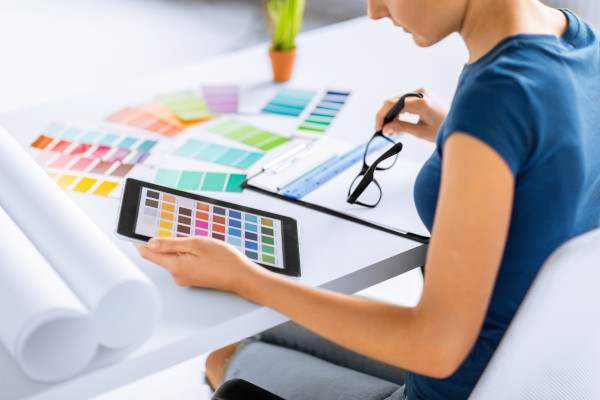
Water Element Colors
Black: In Feng Shui, the color black represents money and wealth; it is ideal for careers, especially when coupled with metal. Black is also associated with the water element, which is associated with serenity, wisdom, and quiet contemplation. It represents emotional strength and protection in Feng Shui. Black indicates introspection and a void.
It also represents the yin side of the Yin Yang symbol. In many countries, the color black is linked to darker concepts, but in feng shui, it is also linked to depth and personal exploration in a more positive way. Use black sparingly and intelligently to allow more wisdom into your home.
- Energy: Yang
- Element: Water
- Bagua map area: Career
Blue: According to Feng Shui, blue has yin energy and is peaceful and serene. This color is significant in Feng Shui because it reflects love as it is healing and relaxing. Blue evokes feelings of peace and trust, and it is associated with self-awareness and understanding. Feng Shui correlates it with adventure and travel because it is the color of the sea and sky. Navy blue denotes intelligence and wisdom, whereas dark blue represents abundance.
Blue is associated with happiness in Buddhism, as shown by the lapis-colored Medicine Buddha.
- Energy: Ying
- Element: Water
- Bagua map area: Family and Knowledge.
Element Wood Colors
Green: Green denotes stability, peace, fertility, and abundance in Feng Shui. It is associated with the element wood. These colors evoke renewal, expansion, and fresh beginnings. As the color of life in the natural world, it is also employed to attract financial wealth because it represents prosperity in its purest form.
Green is associated with the Family section of the feng shui bagua map. When working with the color green in feng shui, it is important to have at least a few different shades.
- Energy: Yang
- Bagua map area: Family
- Element: Wood
Dark Brown: Brown is an Earth tone, which means it is about nurturing, grounding, stability, and self-care. Dark Brown wood floors and furnishings are a great way to bring the wood element into your home. (To clarify: Light brown indicates earth because it is the color of beach sand, while dark brown represents wood because it is the color of tree bark.)
- Bagua map area: Family and Community
- Element: Wood
| SECTOR | SUITABLE COLORS | UNSUITABLE COLORS |
|---|---|---|
| Travel – Helpful People (NW) | Metal & Earth element colors | Water & Fire element colors |
| Career – Life Path (N) | Water & Metal element colors | Earth & Wood element colors |
| Education – Self Cultivation (NE) | Earth & Fire element colors | Metal & Wood element colors |
| Children and Creativity (W) | Metal & Earth element colors | Water & Fire element colors |
| Good Fortune – Well-Being (Center) | Earth & Fire element colors | Metal & Wood element colors |
| Family – Health (E) | Wood & Water element colors | Fire & Metal element colors |
| Love – Relationship (SW) | Earth & Fire element colors | Metal & Wood element colors |
| Fame – Reputation (S) | Fire element colors | Earth & Water element colors |
| Wealth – Prosperity (SE) | Wood & Water element colors | Fire & Metal element colors |
🍀 Our “Feng Shui Master” app is your trusted companion, offering a useful guide to implementing Feng Shui principles. Try it now!
Feng Shui Colors for Every Room
After all this information on how to use feng shui colors in your home, let’s see some simple suggestions for specific rooms.
Feng Shui Colors for Living Room
The colors and energies of the bagua’s health & family, creativity & children, and money & prosperity regions could benefit the living room. By adding colors from these locations, you can improve those areas inside your living room, regardless of where they appear on the bagua map.
Every living room is unique, as are the activities and moods in each home. The most significant aspect is selecting colors that are attractive to you and emit positive energy to stimulate the use of the living area. You can experiment with the following colors:
- Warm Neutrals: Colors such as gray and taupe create the tone for a relaxing living area.
- Green: Whether vibrant or soft, green provides an infinite number of options for matching the energy level of your home.
- Blue: Blue is a very livable color since it is upbeat, pleasant, and welcome. For the living area, navy blue is a versatile neutral.
- Yellow: Soft or brilliant yellow and gold might be the perfect accent to bring a touch of yang to soften yin energy.
Feng Shui Colors for Dining Room
A dining room in the health & family or wealth & prosperity sections of the bagua is auspicious. It is a crucial space for cultivating abundance and happy family reunions. To create a harmonious space, your color scheme might integrate both bagua sections and their elements. The greatest feng shui dining room colors to achieve this include:
- Cream: This natural neutral color emits a relaxing and fortunate vibe.
- Beige: This soothing neutral color complements bright feng shui dining room colors effectively.
- Pink and peach: These are warm, inviting colors that encourage happy gatherings.
- Green: Calming tones of green entice family and friends to stay and eat together.
- Yellow: This color inspires and generates a positive vibe.
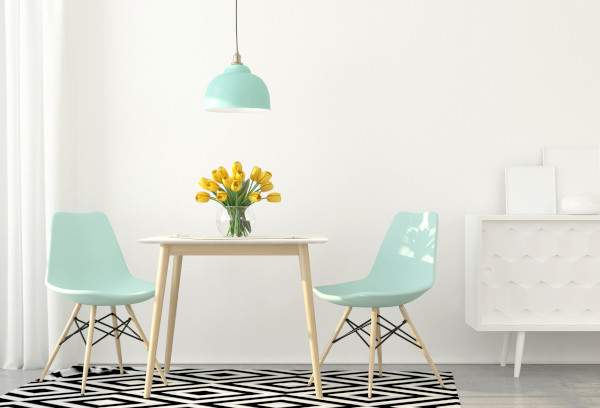
Feng Shui Colors for Kitchen
Because the kitchen has strong yang fire energy, choose colors to moderate the fire energy while fostering cheerful family energy. To achieve this, try the following colors:
- Green: All shades of green and brown are a representation of the wood element, which fuels the fire element.
- Orange: Orange is another fire element hue that works well as an accent color.
- Brown: This wood element color is frequently found in cabinets and flooring.
- Yellow: Yellow can be a lively color that complements the fire aspect without overpowering the space.
- Cream: Cream and mild white are ideal cabinetry colors that bring feng shui balance to brighter colors.
- Red: The most vibrant fire element color, which may create havoc in the kitchen if applied excessively.
Related reading: Use Your Personal Birth Element to Feng Shui Your Wardrobe for Success– Opens in new tab
Feng Shui Colors for Bathroom
Since wastewater is negative chi and its downhill flow symbolizes the loss of riches, bathrooms are seen as unlucky places. Warm accents or artwork showing warm regions might help to balance the water element in your bathroom. In this manner, you can promote yin energy, which is good for the restroom. Try these colors:
- Warm Neutrals: Use the broad color range of white, cream, and all browns to suppress unlucky wastewater.
- Gold and pale yellow: Including soft yellow elements in the linens and artwork can subtly warm up the color scheme of a bathroom.
- Soft Green: Use soft green to balance out the extra water energy in your bathroom.
- Spa Blue: Blue colors boost water activity, yet this delicate green undertone prevents it from being sterile.
- Gray: To counteract the strong metal energy of nickel and stainless steel bathroom fixtures, look for deep grays and greiges.
Want to learn more about Feng Shui? Check out our suggestions: Feng Shui Bookshelf – Opens in new tab
Feng Shui Colors for the Front Door
The finest front door color in feng shui is the one that corresponds with the cardinal directions, despite the fact that there are numerous suggestions as to what that color should be. To find the direction of your front door, stand in front of it and look out. Then, use a compass to figure out which way your house is facing.
For example, if your house faces south, the best color to choose is red (as shown in this color table). The chart below will help you make selections based on the orientation of your home.
Also, keep in mind that if the color of the feng shui front door does not catch your eye or seize your attention, it should be abandoned.
The major purpose of door color is to improve feng shui and attract visitors. When it comes to painting your front door for feng shui, keep in mind your own preferences as well as the fundamentals.

End Words
Conscious use of color can improve your life. The purpose of feng shui color is to help you achieve your goals and to attract positive energy into your home. The best color scheme is one that boosts your space’s comfort and energy. Remember that different shades have different meanings, so keep that in mind.
Personal choice still plays a big part in color choice, whether you decide to develop a color palette that is motivated by the bagua map or feng shui elements. If you don’t like the colors you chose, all positive chi generated by using element colors or the Bagua map will be deleted. With so many color options, you can choose the perfect tint for your room. Above all, remember to have fun!
Here are some of the most popular feng shui rules, organized by room, from our other articles.
- Feng Shui Rules and Tips for Your Front Door and its Surroundings
- Best Feng Shui Rules and Tips for the Living Room
- Basic Feng Shui Rules and Tips for Dining Room
- Basic Feng Shui Rules and Tips for Kitchen
- Basic Feng Shui Rules and Tips for the Bedroom
- How to Feng Shui Your Bathroom
- Basic Feng Shui Rules and Tips for Staircases and How to Apply them
- Simple Guide to Feng Shui Your Workspace
- Feng Shui Your Garden: Design Your Dream Garden with Feng Shui Principles
🍀 Our “Feng Shui Master” app is your trusted companion, offering a useful guide to implementing Feng Shui principles. Try it now!
Stay in Touch
 Join our newsletter by using the forms on this website or click here!
Join our newsletter by using the forms on this website or click here! Follow us on Google News
Follow us on Google News Follow us on Facebook
Follow us on Facebook
Feature Image from Depositphotos

